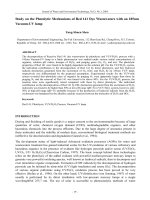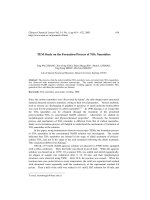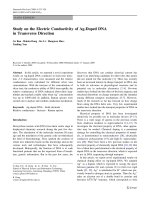Study on the analytical application of matrix assisted laser desorption ionization mass spectrometry imaging technique for visualization of polyphenols
Bạn đang xem bản rút gọn của tài liệu. Xem và tải ngay bản đầy đủ của tài liệu tại đây (3.31 MB, 123 trang )
Study on the analytical application of matrix-assisted laser
desorption/ionization mass spectrometry-imaging technique
for visualization of polyphenols
Nguyen Huu Nghi
Kyushu University
2018
List of contents
Chapter I ....................................................................................................................... 1
Introduction .................................................................................................................. 1
Chapter II ................................................................................................................... 11
Enhanced matrix-assisted laser desorption/ionization mass spectrometry
detection of polyphenols ............................................................................................ 11
1. Introduction ............................................................................................................ 11
2. Materials and methods .......................................................................................... 14
2.1. Materials ...............................................................................................................14
2.2. Sample and matrix preparations ...........................................................................14
2.3. MALDI-MS analyses............................................................................................15
2.4. Statistical Analyses ...............................................................................................15
3. Results and discussion ........................................................................................... 16
3.1. Screening of matrix reagents for negative MALDI-MS detection of monomeric
and condensed catechins
....................................................................................................16
3.2. Effect of concentration of nifedipine on negative MALDI-MS detection of
monomeric and condensed catechins...........................................................................23
3.3. Photobase reaction of nifedipine as matrix in MALDI.........................................27
3.4. Proton-abstractive reaction of nifedipine in flavonol skeleton .............................32
3.5. Potential of nifedipine as matrix reagent for polyphenol detection ......................34
i
4. Summary................................................................................................................. 39
Chapter III.................................................................................................................. 40
Application of matrix-assisted laser desorption/ionization mass spectrometryimaging technique for intestinal absorption of polyphenols ..................................
40
1. Introduction ............................................................................................................ 40
2. Materials and methods .......................................................................................... 42
2.1. Materials ...............................................................................................................42
2.2. Intestinal transport experiments using rat jejunum membrane in the Ussing
Chamber system. .........................................................................................................42
2.3. LC-TOF-MS analysis ...........................................................................................44
2.4. Preparation of intestinal membrane section and matrix reagent ...........................45
2.5. MALDI-MS imaging analysis ..............................................................................46
3. Results and discussion ........................................................................................... 46
3.1. Optimization of MALDI-MS imaging for visualization of monomeric and
condensed catechins in rat jejunum membrane ...........................................................46
3.2. In situ visualization of monomeric and condensed catechins in rat jejunum
membrane by MALDI-MS imaging ............................................................................48
3.3. Absorption route(s) of monomeric and condensed catechins in rat jejunum
membrane ....................................................................................................................52
3.4. Efflux route(s) of monomeric and condensed catechins in rat jejunum membrane
.....................................................................................................................................56
ii
3.5. Visualized detection of metabolites of monomeric and condensed catechins
during intestinal
absorption.....................................................................................................60
4. Summary................................................................................................................. 68
Chapter IV .................................................................................................................. 71
Conclusion .................................................................................................................. 71
References ................................................................................................................... 77
Acknowledgement ...................................................................................................... 88
3
Abbreviations
4
1,5-DAN, 1,5-diaminonaphthalene
9-AA, 9-aminoacridine
desorption/ionization
ABC, ATP-binding cassette
spectrometry
ADME, absorption, distribution,
MCT, monocarboxylic transporter
metabolism, and excretion
MeOH, methanol
AMPK, adenosine monophosphate
MRP2, multidrug resistance protein
activated-protein kinase
ANOVA, analysis of variance
BCRP, breast cancer resistance
Nd:YAG,
neodymium-doped
yttrium aluminum garnet
protein
CHCA,
OATP, organic anion transporting
polypeptides
α-cyano-4-
hydroxycinnamic acid
PA, proton affinity
DHB, 2,5-dihydroxybenzoic acid
PepT1, peptide transporter 1
DMAN,
P-gp, P-glycoprotein
a
m
in
o)
na
p
ht
ha
le
ne
ga
ll
at
F
A,
I
A
IT
O,
in
L
C,
li
1,8-bis(dimethyl-
S/
N,
si
g
na
lto
n
oi
T
mass
2
MALDI-MS, matrix-assisted laser
F3
T
F
T
H
tri
h
y
T
O
F,
5
Chapter I
Introduction
A popular beverage of tea, derived from the leaves of the Camellia
sinensis plant, has been consumed worldwide, and to date, it is considered that
the tea intake would be of health-benefit owing to dietary flavonoids
(polyphenols). In green or non-fermented tea, major components are
monomeric catechins, e.g., epicatechin (EC), epicatechin-3-O-gallate (ECG),
epigallocatechin (EGC), and epigallocatechin-3-O-gallate (EGCG). On the other
hands, by fermentation of tea leaves to produce black tea, oxidation and
polymerization reactions occur in leaves to form oligomeric catechins, such as
theasinensins and theaflavins (TFs) including theaflavin (TF), theaflavin-3-Ogallate (TF3G), theaflavin-3’-O-gallate (TF3’G), and theaflavin-3-3’-di-Ogallate (TF-33’diG)
[1]
. To date, extensive studies have been performed on
health-benefits of tea polyphenols, and showed their potential in preventing
cardiovascular diseases [2], diabetes [3], and cancers [4].
1
Irrespective to the evidences on their preventive effects, it must be
essential to know absorption, distribution, metabolism, and excretion (ADME)
behavior, since the understanding of ADME is indispensable for elucidating the
bioactive mechanism(s) and effective dosage of polyphenols in our body. In
general, polyphenols are thought to be absorbed into the circulation system,
following distribution at organs, and/or excretion into urine and fecal via
metabolism [1]. Among catechins, EC and EGC have been reported to be highly
bioavailable, compared to gallate catechins such as ECG and EGCG
[5]
. In
human study, EC, EGC, ECG, and EGCG were detected in plasma to be 174,
145, 50.6, and 20.1 pmol/mL, respectively, after the consumption of tea
catechins (EC,
36.54 mg; EGC, 15.48 mg; ECG, 31.14 mg; EGCG, 16.74 mg)
[6]
. Another
human study also revealed the absorption of not only catechins, but also their
conjugates in plasma at >50 ng/mL [7]. They also clarified that ECG and EGCG
were absorbed in their intact form, while EC and EGC were susceptible to
metabolism to produce conjugated forms
[7]
. Another research group reported
high stability of EGCG during absorption process in human
[8]
. In cell-line
experiments using Caco-2 cell monolayers, non-gallate catechin, EC, was found
to show lower cellular accumulation than gallate ECG, due to high efflux back
of EC to apical side [9]. After 50-µmol/L, 60-min, Caco-2 transport experiments
of EC, ECG, and EGCG, only gallate catechins (ECG and EGCG) were
predominantly accumulated in cells at 3037 ± 311 and 2335 ± 446 pmol/mg
protein, respectively [10].
2
There were few researches on absorption of black tea TFs. In human
study, even at high dose intake of 700 mg TFs, plasma and urine levels of TFs
were as low as 1 and 2 ng/mL, respectively [11]. In urine, TFs were not detected
after consumption of 1000 mg of TF extract [12]. Non-absorbable property of TFs
was also confirmed by Caco-2 cell transport study, in which TF3’G was not
detected in basolateral side after 60-min transport
[13]
. Irrespective to poor
absorption or low bioavailability of TFs, it was reported that they have
potential in the regulation of intestinal absorption route(s); in turn, TFs may
exert physiological function at the small intestine
[14]
. However, the absorption
behavior of TFs still remains unclear whether they could be incorporated into
intestinal membrane or not.
Once being absorbed into the circulation system or organs, polyphenols
undergo
phase
glucuronidation
II
[15][16]
metabolism,
namely,
methylation,
sulfation,
and
. Phase II enzymes catalyzing the methylation, sulfation,
and glucuronidation are catechol-O-methyltransferase, sulfotransferase, and
uridine diphosphate-glucuronosyltransferase, respectively
[17]
. These metabolic
enzymes were found not only in the intestine, but also in the liver and the
kidneys
[18][19][20]
. It has been reported that higher absorbable catechins such as
EC and EGC were more susceptible to such metabolic reactions, compared to
gallate catechins (ECG and EGCG)
[7]
. For EC absorption, a predominant
sulfate conjugate of EC were effluxed from the enterocytes back to the
intestinal perfusate, while glucuronide conjugate was absorbed into blood, bile
3
and urine [21]. When 500 mL of green tea was given to 10 volunteers, only intact
ECG and
4
EGCG were found in human plasma, whereas glucuronide, methyl-glucuronide,
and methyl-sulfate conjugates of EC and EGC were detected
studies of EGCG in mice
[15]
or ECG in Wistar rats
[22]
[5]
. In absorption
, their sulfate and
glucuronide conjugates were found in blood, liver, and kidney, suggesting that
overall absorption study is still required for further understanding of polyphenol
bioavailability.
The low bioavailability of polyphenols is in part due to their pumping
out (or efflux) to the apical compartment and/or metabolic degradation. In vitro
studies suggested that the routes involved in efflux of polyphenols are ATPbinding cassette (ABC) transporters such as multidrug resistance protein 2
(MRP2) and P-glycoprotein (P-gp), which are located in the apical side
[23]
. In
Caco-2 cell transport experiments of monomeric catechin (EC), inhibition of
MRP2 route by MK-571, an inhibitor of MRP2, significantly reduced the
effluxes of EC and its sulfate conjugates to the apical compartment
[24]
. In
MRP2 transfected and P-gp transfected cells, it was demonstrated that the
cellular accumulation of ECG was significantly increased by both MRP2 and Pgp efflux inhibitors, suggesting the involvement of ECG in both ABC
transporters [10].
In order to get inside into the absorption and metabolism behaviors of tea
polyphenols, some analytical evaluations have been reported. In in vivo
evaluation, transport routes of polyphenols may not be fully explored
[25][26]
.
Thus, to elucidate intestinal absorption and metabolism of polyphenols, cell5
based in vitro model, commonly Caco-2 cell, has been widely used. Caco-2
cells, which
6
are derived from human colon carcinoma, resemble the enterocytes and express
transport systems as in small intestine [27]. By using Caco-2 transport system in
combination with transporter inhibitors, investigations on transport routes of
polyphenols have been widely performed [10][28]. Irrespective to easy set of cellline experiments, Caco-2 cell model remains some disadvantages such as
different protease expression from actual intestinal membranes. An alternative
strategy for absorption study has been proposed by using ex vivo Ussing
Chamber system, which is mounted with animal intestinal membranes
[29][30]
.
Miyake et al. [29] evaluated intestinal absorption of drugs with different levels of
membrane permeability using rat and human intestine mounted onto the Ussing
Chamber system
[29]
. The ex vivo system is considered to be a good tool for
investigating transport mechanism as in vivo intestinal absorption events, and is
used for transport of drugs [29][30], and peptides [31].
It should be noted that analytical assays to monitor target analytes must
be needed for absorption study, even though appropriate absorption systems are
available. To date, liquid chromatography-mass spectrometry (LC-MS) in
electrospray ionization (ESI) mode is commonly used for absorption study of
polyphenols
[32]
, since LC-MS system could detect not only target polyphenols,
but also metabolites simultaneously or one-in-run assay. Irrespective to its high
sensitivity and throughput characteristics, LC-based method remains some
drawbacks; it requires tedious pre-treatments such as preparation and extraction
steps, and could not obtain the localization of analytes in biological tissues
[33]
.
On the other hand, matrix-assisted laser desorption/ionization MS (MALDI-MS),
5
generally known as “soft” ionization that can produce intact pseudomolecular
ion species without fragmentation is currently used for simultaneous and
selective detection of targets even in complex matrices including low and high
molecular compounds
[34]
. The advantages of MALDI-MS are high sensitivity
and selectivity by selected mass units, as well as high speed and tolerance for
impurities
[34][35]
. Therefore, MALDI-MS has been used for diverse ionizable
compounds such as proteins, lipids, and drugs
[36]
. Currently, development of
MALDI-MS-aided imaging technique receives much attention, since the
extensive technique can provide not only the detection of targets presented in
sample tissues, but also the distribution or localization in them
[33]
. The
combinational information of MS detection with spatial distribution, thus,
opens a novel scientific field regarding food and drug delivery system
[33]
.
Thus far, there have been some reports on the application of MALDI-MS
imaging for analyses with wide mass ranges of peptides, proteins, lipids, drugs,
and food compounds
[31][37][38][39]
. It is suggested that the MALDI-MS imaging
technique has potential for elucidating the ADME of drugs and food
compounds [40][41]. As illustrated in Figure 1-1, target tissues are cryosectioned
into µm-thick slides and mounted onto indium-titanium oxide (ITO)-coated
glass slides. Sliced sections are, then, sprayed and coated with MALDI matrix
reagents. Upon irradiated by e.g., neodymium-doped yttrium aluminum garnet
(ND:YAG) laser, the sprayed matrix reagent absorbs the light energy at 355 nm
to desorb and ionize the analytes in the matrix plume. The analytes are detected
at mass-to-charge (m/z)
6
value (for MALDI-MS imaging application, they are visualized with ion
density image).
7
Figure 1-1. Schematic workflow of matrix-assisted laser
desorption/ionization mass spectrometry imaging
8
According to the aforementioned points, the aim of the present research
was to apply MALDI-MS imaging technique to elucidate intestinal absorption
and metabolism(s) of polyphenols with less active in MALDI. In order to
achieve the objective, the following works have been conducted.
Since there have been few reports on matrix reagents for significant
MALDI-MS detection of polyphenols, in Chapter II, appropriate matrix
reagents for MS detection of polyphenols were screened. By considering
molecular property of neutral polyphenols, a subtraction reaction of proton
from polyphenol molecule was targeted in this study. According to this
strategy, matrix reagents that possess molecular property capable for the
formation of nitrosophenyl pyridine moiety when an ultraviolet (UV) is
irradiated in MALDI process were examined. Under the optimal MALDI
conditions, diverse polyphenols including flavonols, flavones, flavanones,
flavonones, chalcone, stilbenoid, and phenolic acid were successfully ionized.
Under the established MALDI conditions for polyphenols, in Chapter
III, novel in situ MALDI-MS imaging concept or analytical application was
proposed to elucidate intestinal absorption behavior of polyphenols on the basis
of visualization-guided evidences. By using the Ussing Chamber transport
system mounted with rat intestinal membranes, non-absorbable and absorbable
polyphenols were subjected to ex vivo transport experiments. Membrane
segments after the transport were, then, analyzed by established MALDI-MS
imaging. As a result, both targets were successfully detected or visualized in
9
tissue segments by the technique. In addition, with the aid of inhibitors that can
block influx/efflux transport routes, MALDI-MS imaging allow to clarify the
absorption mechanism visually, together with visualized metabolic degradation
during absorption process.
10
Chapter II
Enhanced matrix-assisted laser desorption/ionization mass
spectrometry detection of polyphenols
1. Introduction
Polyphenols, which are polyhydroxyl aromatic compounds, naturally
occurring in a variety of fruits and vegetables, could exhibit preventive effects
against cardiovascular diseases
[2]
, diabetes
[3]
, and cancers
[4]
. However, their
ADME behavior remains unclear by diverse metabolism such as methylation,
sulfation, and glucuronidation
[16][42]
. In order to get insight into the
bioavailability of polyphenols, LC-MS using ESI have been widely used, owing
to their high selective and high sensitive detection properties
[11][43]
. However,
the application of LC-MS for absorption study is limited due to the lack of
standards for each metabolite. In contrast, MADLI-MS ionization allows
simultaneous detection of low- to high-molecular-weight compounds
[34][35]
.
Currently, MALDI-MS imaging technique has been received much attention,
since the technique provides not only information of compounds presented in
11
samples, but also their distribution in biological samples, without the need for
labeling preparation
[15][40]
. Thus, MALDI-MS imaging are becoming
increasingly applied for the visualization of targets in organs, such as
distribution and metabolism of erlotinib, an anti-cancer drug, in the lungs of
tumor-bearing mice [44].
Irrespective to such advantages of MALDI-MS, matrix-dependent
ionization limits its application and requires efforts to develop new matrices
adequate for target compounds. In general, matrix reagent for MALDI requires
following properties: strong absorption at laser irradiation wavelength; good
compatibility of analytes with matrix solvent; good vacuum stability and low
vapor pressure; and participation in some kind of photochemical reactions such
as protonation or deprotonation in gas phase
[35]
. Rational design of MALDI
matrix could be based on physicochemical properties of the expected matrix [45].
Matrix reagents for negative MALDI mode should be a strong base, whereas
high acidity in gas phase seems to be an important characteristic of a matrix for
positive MALDI mode
[45]
. Matrices such as α-cyano-4-hydroxycinnamic acid
(CHCA), sinapinic acid (SA), and 2,5-dihydrobenzoic acid (DHB) have been
widely used in both negative and positive MALDI detection of proteins,
peptides, and lipids [46]. However, due to some limitations of these conventional
matrices e.g., many interfered signals at the low mass range in positive mode
and low ionization efficiency in negative detection mode, efforts have been
made to screen and develop high ionization efficiency matrices for negative
12
MALDI-MS
[46]
. The use of 9-aminoacridine (9-AA) as a matrix for negative
ionization mode
13
shows high sensitive detection of low-molecular weight compounds such as
carboxylic acids, amines, alcohols, and phenols owing to its high gas-phase
basicity which readily abstracts a proton from analytes
[47]
. A strong base, 1,8-
bis(dimethyl-amino)naphthalene (DMAN) allows detection of low molecular
weight compounds (fatty acids, amino acids, plant and animal hormones,
vitamins and small peptides) in negative MALDI-MS
[48]
. The basic center,
formed by steric position of two dimethyl-amino groups in DMAN, could
deprotonate analytes during MALDI ionization
[48]
.
The matrix 1,5-
diaminonaphthalene (1,5-DAN) has been reported to visualize polyphenols and
their metabolites in rat liver and kidney in negative mode
[15]
. However, the
mechanism of 1,5-DAN as MALDI matrix remains undetermined in the
research.
To date, attempts have been made to detect metal adducts of polyphenols
in positive mode by MALDI-MS using conventional matrices such as DHB and
CHCA
[49]
[34][35]
or to use some matrices such as trans-3-indoleacrylic acid (IAA)
and 1,5-DAN
[15]
in negative MS detection mode. However, poor MALDI-
MS detection of neutral polyphenols still remains problematic due to their lack
of proton-removal or -additional groups. In order to detect polyphenols, a
strategy for screening adequate matrix in this study lies in a compelling
subtraction reaction of a proton from polyphenol molecule. In this Chapter II, a
photobase generator of chemicals (nifedipine in this study) was targeted, since a
photobase can produce a proton-acceptor moiety upon UV-irradiation
[50]
.
EGCG and TF3’G, most common polyphenols in green and black tea, respectively,
14
were selected to evaluate proton subtraction property of matrices under MALDIirradiation.
15
2. Materials and methods
2.1. Materials
CHCA, DHB, 2’,4’,6’-trihydroxyacetophenone (THAP), nimodipine, EC,
EGCG, naringin, and 5-O-methylnaringenin were obtained from Sigma-Aldrich
(St. Louis, MO, USA). 1,5-DAN and resveratrol was purchased from Tokyo
Chemical Ind. (Tokyo, Japan). Nitrendipine, amlodipine, TF3’G, hesperidin,
sakuranetin (7-O-methylnaringenin), luteolin, acacetin, curcumin, and quercetin
were purchased from Nacalai Tesque Co. (Kyoto, Japan). Nifedipine, IAA,
kaempferol, and ellagic acid were obtained from Wako Pure Chemical Ind.
(Osaka, Japan). 9-AA was obtained from Merck Millipore (Darmstadt,
Germany). Procyanidin B2 and isosakuranetin (4’-O-methylnaringenin) were
obtained from Extrasynthese (Lyon, France). Theasinensin A was synthesized
according to the method by Tanaka et al. [51]. Briefly, EGCG was oxidized with
Japanese pear homogenate to obtain dehydrotheasinensin A. Ascorbic acid, then,
was added to dehyrotheasinensin A, followed by elution with methanol (MeOH)
in MCI-gel CHP 20P column (Mitsubishi Chemical Co., Tokyo, Japan) to obtain
theasinensin A. Naringenin was purchased from MP Biomedicals LLC. (Santa
Ana, CA, USA). All other chemicals were of analytical grade and were used
without further purification.
2.2. Sample and matrix preparations
16
Polyphenols used in this study were dissolved in MeOH/water (50/50,
v/v). Matrix reagents were dissolved in acetonitrile/water (3/1, v/v) solution.
Polyphenol solution at concentrations of 0.1 ‒ 200 µmol/L was mixed with an
equal volume of matrix solution (2 ‒ 30 mg/mL). An aliquot (0.2 µL,
corresponding to 0.01 ‒ 20 pmol each) of the polyphenol solution was manually
spotted onto an ITO-glass slide (Bruker Daltonics, Bremen, Germany). After
drying in air at room temperature, optical images of the spotted matrix crystals
on ITO-coated glass slide were taken by a microscope BZ-9000 (KEYENCE,
Osaka, Japan).
2.3. MALDI-MS analyses
MALDI-MS analysis was performed using an Autoflex III MS equipped
with SmartBeam III (Bruker Daltonics). MS data were acquired in the range of
100–1000 m/z by summed signals from 100 consecutive laser pulses on the
spotted sample area. The MS parameters were as follows: ion source 1, 20.00
kV; ion source 2, 18.80 kV; lens voltage, 7.50 kV; gain factor, 2.51, laser
frequency, 200 Hz; laser power, 100%; offset, 60%; range 20%, laser focus
range,
100%; value, 6%. Signal intensity and signal-to-noise (S/N) ratio were
calculated as a sum of MS data from 100 randomly selected positions on the
whole spotted area using the batch analysis function in Flexanalysis 3.3 (Bruker
Daltonics).
2.4. Statistical Analyses
17









